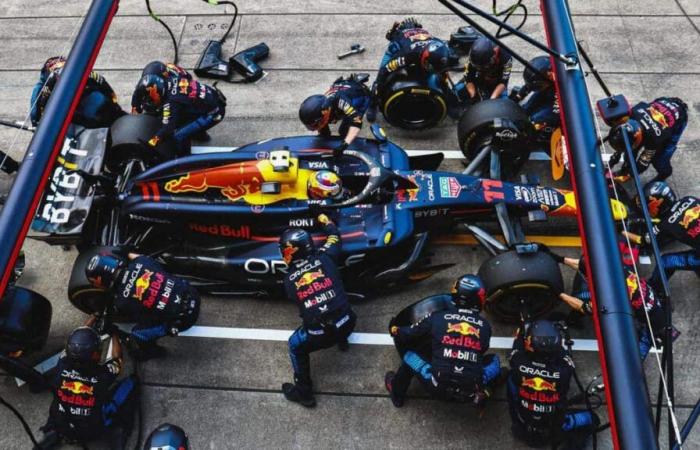- The rise of Formula 1 in the United States: from niche to 3 large awards and mass audiences.
- “Drive to Survive”, from Netflix, and digital strategy transform the fans base, attracting young people and women.
- The F1 built a sports brand in that country by merging culture, technology and entertainment beyond the track.
Formula 1, since its foundation in 1950, was positioned as a synonym for luxury, technology and adrenaline. It is a phenomenon that transcends the careers, operating as an economic giant and an innovation laboratory, with an annual movement of more than 2.5 billion dollars.
However, in the US market, traditionally dominated by sports such as American football or basketball, F1 always had the problem of a less enthusiastic reception. The Grand Prix in Las Vegas was described as “the event in the parking lot of a casino.”
But nothing is forever: the panorama has now changed radically. The F1 is experiencing a strong boom in the United States, a country that now houses three major awards: Miami, Austin and Las Vegas.
Events such as the Miami Grand Prix last week attract hundreds of thousands of attendees, something unthinkable a decade ago.
According to an analysis by The Drum, despite the fact that sport will turn 75, its chapter in the United States It resembles an emerging company in mode of hypercrection.
A more than interesting fact to see this growth: just in 2017, less than 10 years ago, the F1 had no digital platforms or social networks, something that contrasts with its current state: 850 million fans worldwide, with the greatest increase observed precisely in the United States.
Formula 1 and the United States: new strategy, new audience
A determining factor in this transformation was the strategic approach implemented under the property of Liberty Media, which acquired the F1 in 2017.
The new administration promoted digital and global expansion, vital to reach new audiences.
One of the most notable achievements in this direction was the documentary series “Drive to Survive” produced by Netflix.
Released in 2019, at a time when F1 saw her audience aged and some races were too predictable, the series managed to open access to the world behind the paddock.
“Drive to Survive” humanized the pilots, making them characters with whom the audience could connect emotionally, transforming F1 into a type of High speed reality show.
This narrative approach had a direct impact on the demography of the fans. In the United States, 70% of the new followers are under 35 years old, and 40% are women.
At the global level, more than half of the new fans (53%) are under 35 years. These new followers often approach sport through platforms such as Netflix or Tiktok, instead of traditional television broadcasts.
This dynamic has cultivated a different type of brand value in the United States, where there is a greater affinity for formula one as a brand itself, beyond loyalty to specific equipment or pilots.
Formula 1: Beyond the track
The F1 strategy consists, according to The Drum, to create multiple access points for fans. It is no longer essential to understand the technical aspects such as DRS zones or tire strategies to be a follower of sport. You can reach it through culture, music, fashion, celebrities or social networks.
This cultural connection is essential to attract the American public.
The pilots themselves have become global superstars and influencers, with figures such as Lewis Hamilton collaborating with fashion brands and being a social activist, or Max Verstappen generating millionaire income.
This brand and narrative ecosystem attracts elite sponsors, including brands that disburse up to 100 million dollars per season for their agreements.
Formula one also captures the interest of B2B companies looking for an authentic narrative for their brands. An example is GlobantTechnological partner of the F1, which began solving a specific need (improving the data interface on the boxes) and evolved towards a deeper integration, which Globant describes as something that “hits” (makes it sticky).
As we told you in Merca2.0, the organization made a brand redesign, focused on the “race line”, which is applied in all its channels and contact points.
The objective is to cultivate a deep emotional connection with sport, focusing both in spectacular times and in daily experience.
The large -scale show: logistics and experience
The new operational scale of the formula is not only a necessity, but reinforces the brand image as a sophisticated and technologically advanced sport.
R&D investment by teams can rival that of large technology companies. The visibility of these operations, as well as technological innovations (hybrid motors, advanced materials, safety such as halo), contributes to the narrative of the F1 as an engine of the future.
The ability of the F1 to execute events of this scale and complexity, while offering a cohesive and attractive brand experience, is an important step in its consolidation in the US market.
Now read:
BBVA and the purchase of Sabadell: Government of Spain will make a public consultation
Are Zara, Uniqlo and H&M representatives of Fast Fashion or Premium brands?
Mongolia has a goal: that tourism represents 10% of its GDP
⇒ Subscribe to our contents on Google News





